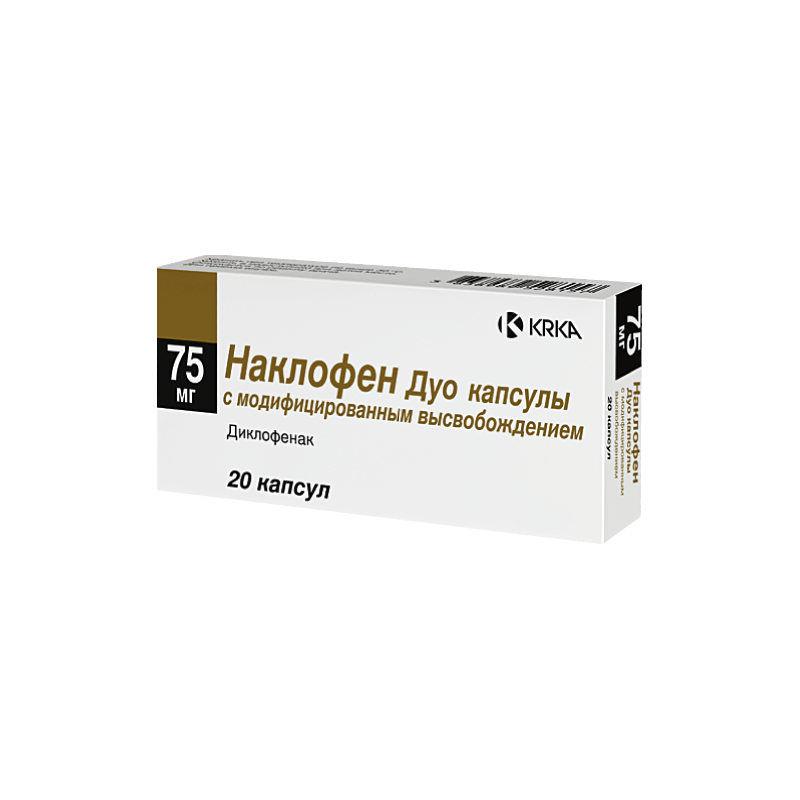



 All payments are encrypted via SSL
All payments are encrypted via SSL
 Full Refund if you haven't received your order
Full Refund if you haven't received your order
1 capsule contains 75 mg of Diclofenac sodium
20 pieces
NACLOFEN DUO has anti-inflammatory, analgesic and antipyretic effects. Most effective for inflammatory pain.
Inflammatory and degenerative diseases of the musculoskeletal system: rheumatoid, psoriatic, juvenile chronic arthritis, ankylosing spondylitis (Bechterew's disease), neuralgic amyotrophy (Turner-Turner’s disease), osteoarthritis, rheumatism, gouty arthritis (with an acute syndrome) and asymptoma arthritis in Reiter’s disease.
Pain syndrome: headache (including migraine) and toothache, bursitis, tendonitis, lumbago, sciatica, ossalgia, neuralgia, myalgia, arthralgia, radiculitis, in case of cancer, post-traumatic and postoperative pain, accompanied by inflammation.
Algomenorrhea; inflammatory processes in the pelvis, incl. adnexitis; childbirth (as an analgesic and tocolytic agent).
Infectious and inflammatory diseases of ENT organs with severe pain syndrome (as part of complex therapy): pharyngitis, tonsillitis, otitis. Feverish syndrome with colds and infectious diseases.
Hypersensitivity
100 mg 1 time per day (for dysmenorrhea and migraine attacks - up to 200 mg / day). When taking 100 mg of retard, if necessary, increase the daily dose to 150 mg, you can additionally take 1 regular pill (50 mg).
On the part of the digestive system: abdominal pain or spasm, bloating, diarrhea, dyspepsia, nausea, constipation, flatulence, increased activity of liver transaminases, peptic ulcer, including with complications (perforation, bleeding), Gastrointestinal bleeding without an ulcer, vomiting, jaundice, melena, blood in the feces, damage to the esophagus, aphthous stomatitis, dry mucous membranes (including the oral cavity), hepatitis, hepatonecrosis, cirrhosis, hepatorenal syndrome, change in appetite, pancreatitis (including with concomitant hepatitis), colitis.
Nervous system: headache, dizziness, sleep disturbance, drowsiness, depression, diplopia, anxiety, irritability, aseptic meningitis, convulsions, weakness.
Special senses: tinnitus., blurred vision, a violation of taste, hearing loss (including irreversible), scotoma.
From the skin: skin rash, itchy skin, alopecia, urticaria, eczema, toxic dermatitis, multiforme exudative erythema (including Stevens-Johnson syndrome), toxic epidermal necrolysis (Lyell syndrome), photosensitization.
From the genitourinary system: fluid retention, nephrotic syndrome, proteinuria, oliguria, interstitial nephritis, papillary necrosis, acute renal failure, azotemia.
From the side of blood-forming organs: anemia (including hemolytic and aplastic), leukopenia, thrombocytopenia, eosinophilia, agranulocytosis, thrombocytopenic purpura.
On the part of the respiratory system: cough, bronchospasm, laryngeal edema.
From the CCC: increased blood pressure, congestive heart failure.
Allergic reactions: swelling of the lips and tongue, anaphylactoid reactions, anaphylactic shock (usually develops rapidly).
Increases plasma concentration of Digoxin, Methotrexate, drugs Li + and cyclosporine. Reduces the effect of diuretics, against the background of potassium-saving diuretics increases the risk of hyperkalemia; against the background of anticoagulants, antiplatelet and thrombolytic drugs (alteplaza, streptokinase, urokinase) increases the risk of bleeding (usually the gastrointestinal tract).
Reduces the effect of antihypertensive and hypnotic drugs.
Increases the likelihood of side effects of other NSAIDs and GCS (bleeding in the gastrointestinal tract), the toxicity of methotrexate and cyclosporine nephrotoxicity. ASC reduces the concentration of diclofenac in the blood.
Simultaneous use with Paracetamol increases the risk of the development of the nephrotoxic effects of diclofenac. Reduces the effect of hypoglycemic drugs.
Cefamundol, cefoperazone, cefotetan, valproic acid and plykamycin increase the incidence of hypoprothrombinemia. Q-T Cyclosporine and Au preparations increase the effect of diclofenac on Pg synthesis in the kidneys, which is manifested by an increase in nephrotoxicity.
The simultaneous appointment with ethanol, colchicine, corticotropin and St. John's wort preparations increases the risk of bleeding in the gastrointestinal tract. Drugs that cause photosensitization increase the sensitizing effect of diclofenac to UV radiation. Drugs blocking tubular secretion, increase the concentration in the plasma of diclofenac, thereby increasing its effectiveness and toxicity.
Symptoms: dizziness, headache, lung hyperventilation, clouding of consciousness, in children - myoclonic convulsions, nausea, vomiting, abdominal pain, bleeding, impaired liver and kidney function.
Treatment: gastric lavage, Activated carbon, symptomatic therapy aimed at eliminating increased blood pressure, impaired renal function, seizures, gastrointestinal irritation, respiratory depression. Forced diuresis, hemodialysis are ineffective.
Naklofen duo